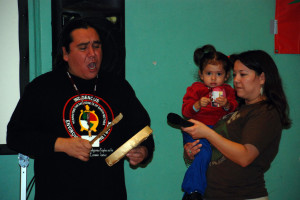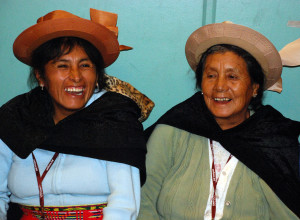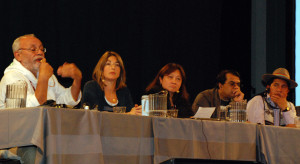Blog post by Anne Petermann, Executive Director, Global Justice Ecology Project & North American Focal Point of Global Forest Coalition. Every day this week she will be posting an update from the World Forestry Congress on this blog
Buenos Aires, Argentina – Rather than writing another lengthy blog post on the absurdities witnessed at the XIII World Forestry Congress in Buenos Aires, today I offer you some of the views of our allies regarding the Congress.
First you will find comments on REDD made by Camila Moreno, who is Global Justice Ecology Project’s Brazilian representative and a New Voices on Climate Change participant. She made the comments during a panel presentation on REDD organized by the Climate Media Partnership at the congress on Thursday, October 22.
My second post is the presentation by Marcial Arias, who is a Kuna from Panama, on the impacts of REDD on Indigenous Peoples. Marcial gave this presentation during the same panel presentation as Camila for the Climate Media Partnership.
Next I have posted an excerpt from a statement by World Rainforest Movement criticizing the claim of the congress to be “carbon neutral.” WRM boycotted the congress, instead writing a detailed and sharp critique of it.
Finally, you will find Global Forest Coalition’s formal letter of resignation to the World Forestry Congress Advisory Board. GFC resigned from the WFC Advisory Board after every recommendation they made was ignored.
Camila Moreno on Brazilian Social Movements Denouncing REDD
Camila Moreno, speaking on behalf of New Voices on Climate Change for the panel organized by the Climate Media Partnership, pointed out the widespread opposition to UN’s REDD scheme by communities, Indigenous Peoples, social movements and organizations in Brazil and throughout Latin America. She began her presentation by reading the Belém Letter: the statement denouncing REDD adopted by Brazilian NGOs and social movements.
You can read the letter at http://www.globaljusticeecology.org/connections.php?ID=323.
She went on to further elaborate the criticism by Latin American groups to including forests in the carbon market, and called for an opening of space for discussion on the true causes of climate change including its underlying drivers, in contrast to the lack of space for any dissent or in-depth conversations found at the World Forestry Congress.
Marcial Arias (of the International Alliance of Indigenous and Tribal Peoples of the Tropical Forest, and Global Forest Coalition) on the Views of Indigenous Peoples on REDD
I have some serious concerns about REDD, which I will explain.
For Indigenous Peoples the trees are more than wood. The trees mean food, medicine, shelter, and that is not being recognized by REDD.
Next, REDD is being promoted for poverty alleviation. I will explore if this is true. First, these types of market mechanisms are not new, we saw something similar through the CDM (Clean Development Mechanism of the Kyoto Protocol) which has had great impacts on Indigenous communities. For example, the CDM has led to the development of monoculture timber plantations and also large dams on Indigenous lands, and these have had very grave impacts on Indigenous peoples. Examples of this exist throughout Latin America and Africa.
The mechanisms of REDD+ include developing monoculture timber plantations. With these plantations comes the use of agro-toxics and herbicides. This is reducing the life expectancy in Indigenous communities, and you can already see the damage to peoples’ health due to tree plantations and associated agro-toxins.
Another important issue is the question of benefits for avoided deforestation. The tradition of the Kuna People is to do small-scale sustainable logging in the summer. It is part of the culture. How much will we be paid to change our culture?
Then there is the problem of informing communities about the problems of REDD. I am reasonably informed, but it is very difficult to explain to the people in indigenous communities just what REDD will mean to them.
Finally, the governments must to take into account the UN Declaration on the Rights of Indigenous Peoples with REDD. It is essential that this UN declaration is taken into account, and it is critical that the people have the ability to say no to these projects. And finally, the traditional knowledge of Indigenous Peoples must be taken into account in the development of REDD.
Excerpt from World Rainforest Movement on the carbon neutral fraud at the World Forestry Congress
For the entire critique, please visit WRM’s website at http://www.wrm.org.uy/
According to its organizers, the XIII World Forestry Congress (WFC), to be held from 18 – 23 October, in Argentina, “will be the first World Forestry Congress which shall achieve ‘Carbon Neutral’ ranking”. The organizers plan to reach such status through the purchase of “carbon credits” from Nobrecel’s “Forestry-industrial Sector Biomass Energy Project” in Brazil.
The monoculture tree plantation “forests”
Before analysing the validity of the “carbon neutrality” claim, it is important to understand where the “carbon credits” are coming from, because this relates directly to the misleading slogan of the WFC: “Forests in Development: a vital balance”.
In line with a definition that equates plantations with forests, the WFC organizers did not find any problem in making a deal with Nobrecel, a company holding an extensive area of eucalyptus “forest” in Brazil, which feeds its pulp mill in the State of São Paulo.
The “carbon neutral” myth
The idea of “neutralising” fossil fuel emissions is based on the premise that the carbon released from burning fossil fuels can in some way be “neutralised” by other activities such as the Nobrecel project. This is simply not possible.
What needs to be understood is that the carbon released through the use of fossil fuels (coal, oil and natural gas) has not been part of the functioning of the biosphere for millions of years. Once fossil fuels are extracted and burnt, that carbon –which until then had been safely stored underground- is released, thereby increasing the above ground carbon stock. Once released, that carbon cannot be returned to its original storage place and the more it is extracted, the more the total amount of carbon in the biosphere is increased, thus further enhancing the greenhouse effect.
In the case of the WFC, the organizers themselves explain that most of the emissions related to its meeting will come from overseas flights. Carbon neutral flights are perhaps the best way to show that this is a cheating game. Planes do not fly on renewables; they run on oil. Once burnt to enable the planes to fly, the carbon contained in the fuel is released. Nothing can make that carbon return back underground.
Instead of channeling money to a company such as Nobrecel –thus subsidizing its destructive activities- the international forestry sector could show its commitment with our Planet by ceasing to promote monoculture tree plantations. Instead of trying to achieve an impossible “carbon neutrality” it could tackle the much more achievable objective of excluding tree monocrops from the definition of forests.
Global Forest Coalition Letter of Resignation to the World Forestry Congress
Dear Mr. Heino,
When Dr. Miguel Lovera as Chairman of the Global Forest Coalition agreed to join the Advisory Committee of the XIII World Forestry Congress, he did so because he hoped he would have been able, as the only representative of Southern NGOs and Indigenous Peoples’ Organizations on this committee, to contribute some of the views of our IPO and NGO members to the preparatory process of the Congress. He and his colleague Simone Lovera, who participated on his behalf in the Advisory Committee meeting in March 2009, submitted various proposals to enhance the participation of Indigenous Peoples’ representatives, Southern NGOs and women in the congress. He also proposed to have a greater emphasis on forest restoration in the congress and to ensure the program of the congress reflected a clear distinction between forest restoration and the expansion of monoculture tree plantations, considering the massive opposition of social movements against the latter.
Regretfully, he did not get any response on these suggestions.
As Miguel Lovera started working as advisor to the Paraguayan Minister of the Environment in June 2009 he asked me to substitute him in the Advisory Committee. When I was accepted as his substitute, I asked you and other members of the Advisory Committee about your response to the proposals GFC had submitted, and about ways I could participate effectively in the work of the Advisory Committee in general. On August 12 I received a response from Ines Matyszczyk that my “message of 9 August has been referred to Mr Olman Serrano, Associate Secretary-General of the XIII WFC, who will get in touch with you directly to follow-up on GFC’s proposal”. But we did not get any response from him or anybody else so far.
We have not been consulted at all about speakers, or other elements of the Congress’ programme. Having now reviewed the final program as it is posted on the WFC website, we feel there is a severe lack of participation of Indigenous Peoples and Southern NGOs amongst the main speakers. Except for two keynote speakers from COICA, the coordinating body of Indigenous Peoples of the Amazon, we recognize hardly any Indigenous peoples’ representatives amongst the speakers.
We feel the program of the congress is very much biased towards industry and government representation and that it lacks representation of Indigenous peoples and forest-dependent communities. We also feel there is a lack of balance between proponents of carbon offsets and wood-based bioenergy and more critical voices amongst the WFC speakers.
Meanwhile, we have understood that specific requests by our Argentine NGO colleagues to allow more local NGOs and social movements to participate in the congress have been denied as well.
In summary, we feel the WFC Organizers have not taken us seriously as part of the advisory committee. Based on our concerns, I regret to inform you that I decided to resign as a member of the Advisory Committee of this congress.
Signed, Andrei Laletin, Global Forest Coalition










